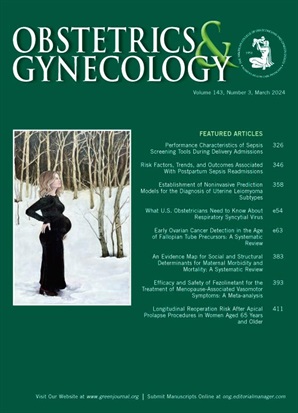Cardiovascular Disease After Hysterectomy in the Nurses' Health Study and Nurses' Health Study II.
IF 5.7
2区 医学
Q1 OBSTETRICS & GYNECOLOGY
引用次数: 0
Abstract
OBJECTIVE To examine long-term risk of cardiovascular disease (CVD) after undergoing hysterectomy with or without oophorectomy. METHODS Participants in the Nurses' Health Study (NHS) and the Nurses' Health Study II (NHS II) (N=239,907) were grouped based on history of no surgery, hysterectomy alone, or hysterectomy with bilateral oophorectomy, and further categorized by use or nonuse of estrogen. The primary outcome was the risk of CVD (combined incidence of fatal and nonfatal myocardial infarction, coronary artery bypass graft and stroke) among the groups. Data were analyzed by multivariable Cox proportional hazards model, stratified by age to estimate adjusted hazard ratios (aHRs). Models controlled for menopausal hormone therapy as well as race, marital status, family income, personal and family history of relevant health conditions, alcohol consumption, physical activity, healthy eating index, body mass index (BMI), and parity. RESULTS After pooling the NHS and NHS II participants, the risk of CVD was higher among all participants who had hysterectomy before age 50 years compared with no surgery. Specifically, those who underwent hysterectomy before age 46 years and did not use estrogen had a 21.0% increased risk of CVD compared with no surgery (aHR 1.21, 95% CI, 1.04-1.40). Furthermore, among estrogen users who had hysterectomy and bilateral oophorectomy, those from the youngest two age groups (younger than 46 years and 46-50 years) had higher risk of CVD (aHR 1.26, 95% CI, 1.16-1.37; aHR 1.11, 95% CI, 1.01-1.22, respectively) compared with no surgery. Non-estrogen users who had hysterectomy with bilateral oophorectomy from all but the oldest age group (older than 60 years) experienced higher risk of CVD compared with no surgery. CONCLUSION Younger age at time of hysterectomy, with or without oophorectomy, is associated with higher risk of CVD. Notably, use of estrogen does not appear to mitigate deleterious effects of hysterectomy with oophorectomy before age 50 years.子宫切除术后心血管疾病的护士健康研究及护士健康研究II。
目的探讨子宫切除术合并或不合并卵巢切除术后心血管疾病(CVD)的长期风险。方法护士健康研究(NHS)和护士健康研究II (NHS II)的参与者(N=239,907)根据未手术、单独子宫切除术或子宫切除术合并双侧卵巢切除术的病史进行分组,并进一步根据使用或不使用雌激素进行分类。主要结局是两组间CVD(致死性和非致死性心肌梗死、冠状动脉旁路移植术和卒中的合并发病率)的风险。采用多变量Cox比例风险模型对数据进行分析,按年龄分层估计校正风险比(aHRs)。模型控制了更年期激素治疗、种族、婚姻状况、家庭收入、相关健康状况的个人和家族史、饮酒、体育活动、健康饮食指数、体重指数(BMI)和胎次。结果:在NHS和NHS II的参与者中,所有在50岁之前子宫切除术的参与者患CVD的风险高于未手术的参与者。具体来说,在46岁之前接受子宫切除术且未使用雌激素的患者与未接受手术的患者相比,心血管疾病的风险增加了21.0% (aHR为1.21,95% CI为1.04-1.40)。此外,在子宫切除术和双侧卵巢切除术的雌激素使用者中,最年轻的两个年龄组(小于46岁和46-50岁)的CVD风险更高(aHR 1.26, 95% CI, 1.16-1.37;aHR为1.11,95% CI分别为1.01-1.22)。除年龄最大的年龄组(60岁以上)外,接受子宫切除和双侧卵巢切除术的非雌激素使用者与未接受手术的患者相比,患心血管疾病的风险更高。结论子宫切除术时年龄较小,无论是否进行卵巢切除术,心血管疾病的风险较高。值得注意的是,在50岁之前,使用雌激素似乎并不能减轻子宫切除术和卵巢切除术的有害影响。
本文章由计算机程序翻译,如有差异,请以英文原文为准。
求助全文
约1分钟内获得全文
求助全文
来源期刊

Obstetrics and gynecology
医学-妇产科学
CiteScore
11.10
自引率
4.20%
发文量
867
审稿时长
1 months
期刊介绍:
"Obstetrics & Gynecology," affectionately known as "The Green Journal," is the official publication of the American College of Obstetricians and Gynecologists (ACOG). Since its inception in 1953, the journal has been dedicated to advancing the clinical practice of obstetrics and gynecology, as well as related fields. The journal's mission is to promote excellence in these areas by publishing a diverse range of articles that cover translational and clinical topics.
"Obstetrics & Gynecology" provides a platform for the dissemination of evidence-based research, clinical guidelines, and expert opinions that are essential for the continuous improvement of women's health care. The journal's content is designed to inform and educate obstetricians, gynecologists, and other healthcare professionals, ensuring that they stay abreast of the latest developments and best practices in their field.
 求助内容:
求助内容: 应助结果提醒方式:
应助结果提醒方式:


